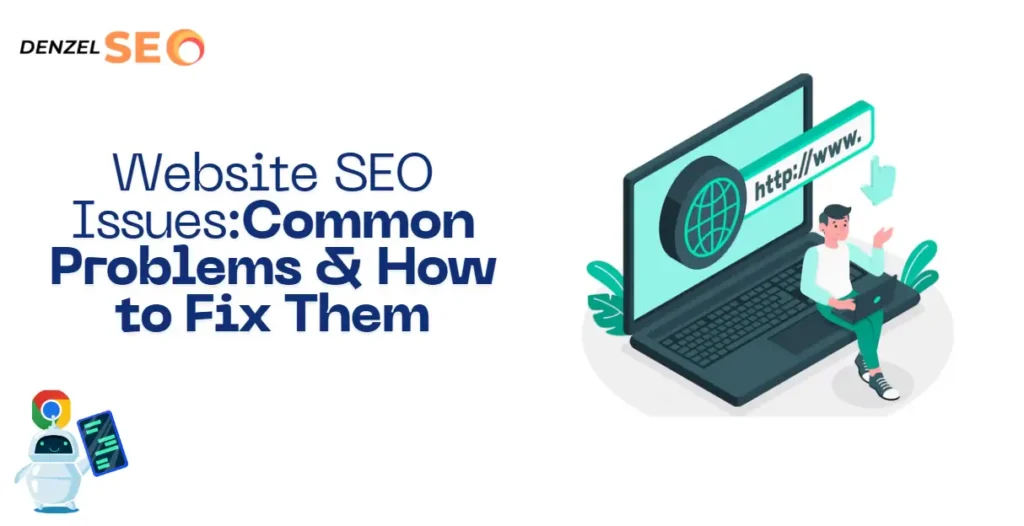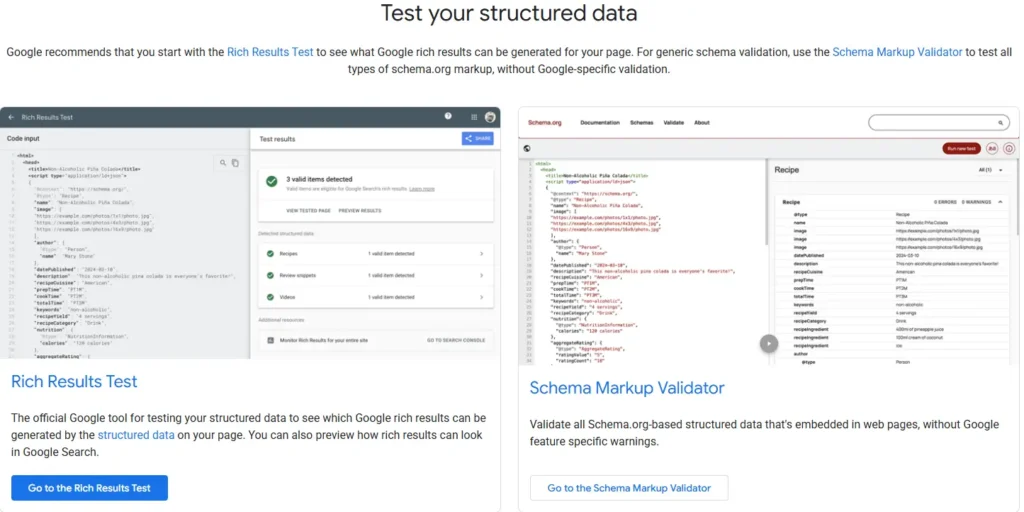Website SEO Issues: Common Problems & How to Fix Them
- March 13, 2025
- Denzel D. Salazar
- 2:41 pm

SEO (Search Engine Optimization) is crucial for website visibility, traffic, and conversions. However, many businesses struggle with common SEO issues that hinder their online success. In this article, we’ll explore the most prevalent SEO problems and provide actionable solutions to fix them.
Common Website SEO Issues
SEO is the backbone of online success. A well-optimized website ranks higher in search engines, attracts organic traffic, and improves user experience. However, various SEO issues can negatively impact your website’s performance, leading to:
- Lower search rankings – Making it harder for potential customers to find you.
- Decreased organic traffic – Resulting in fewer leads and conversions.
- Poor user experience – Increasing bounce rates and reducing engagement.
To maintain a strong online presence, you must regularly audit your website and resolve these SEO issues. Let’s explore the most common problems and how to fix them.
Technical SEO Problems
Technical SEO issues can significantly impact search rankings, user experience, and website performance. Below are some common technical SEO challenges and their solutions.
Issue: Slow Loading Speed
A slow website increases bounce rates, lowers user engagement, and negatively affects search rankings. Even a one-second delay can reduce conversions by 7%. Google prioritizes fast-loading pages, making speed optimization essential.
Fix:
Run a speed test using Google PageSpeed Insights to identify performance bottlenecks and get actionable recommendations.
Optimize images by compressing them with tools like TinyPNG or ImageOptim without compromising quality.
Minify CSS, JavaScript, and HTML by removing unnecessary characters and whitespace to improve load times.
Enable browser caching to store frequently accessed resources and speed up page reloads for returning users.
Issue: Broken Links & 404 Errors
Broken links disrupt user experience and negatively affect crawlability, making it harder for search engines to index your site efficiently. These errors can occur due to deleted pages, URL changes, or incorrect internal linking.
Fix:
Identify broken links using tools like Screaming Frog or Ahrefs.
Fix or redirect broken pages with 301 redirects to ensure users and search engines reach the correct destination.
Regularly audit internal and external links to prevent future issues and maintain a healthy site structure.
Issue: Broken Links & 404 Errors
With over 60% of web traffic coming from mobile devices, Google prioritizes mobile-first indexing. A poorly optimized mobile site can lead to poor rankings, high bounce rates, and a frustrating user experience.
Fix:
Use responsive design to ensure your site adapts to different screen sizes. Test your website with Google’s Mobile-Friendly Test.
Optimize fonts, buttons, and navigation to enhance readability and accessibility on mobile devices.
Reduce intrusive pop-ups that negatively impact user experience and may violate Google’s mobile usability guidelines.
On-Page SEO Issues
On-page SEO ensures that your website is optimized for both search engines and users. Below are key mistakes that can affect rankings and engagement.
Issue: Missing or Duplicate Meta Tags
Meta tags, including title tags and meta descriptions, help search engines understand page content. Missing, duplicate, or poorly optimized meta tags can reduce visibility in search results.
Fix:
Write unique, keyword-rich meta descriptions and title tags for every page to improve click-through rates.
Use SEO plugins like Yoast SEO (for WordPress) or Rank Math to optimize meta tags efficiently.
Issue: Keyword Stuffing
Overusing target keywords can make content sound unnatural and may lead to search engine penalties, reducing rankings.
Fix:
Use keywords naturally within the content, ensuring they blend seamlessly into sentences.
Implement Latent Semantic Indexing (LSI) keywords to enhance topic relevance and avoid repetition.
Issue: Poor Content Structure
Unstructured content affects readability, engagement, and SEO. Search engines and users prefer well-organized content.
Fix:
Use H1-H6 headings correctly to create a clear content hierarchy.
Improve internal linking to help users and search engines navigate related content easily.
Off-Page SEO Challenges
Off-page SEO involves factors like backlinks and brand reputation, which influence domain authority and rankings.
Issue: Low-Quality or Spammy Backlinks
Toxic backlinks from spammy websites can harm your rankings and lead to Google penalties.
Fix:
Audit your backlink profile using tools like Ahrefs or Moz to identify harmful links.
Disavow bad backlinks using Google’s Disavow Tool.
Issue: Lack of High-Quality Backlinks
Strong backlinks from authoritative websites improve trust and search rankings. A weak backlink profile can limit your site’s authority.
Fix:
Publish guest posts on reputable industry-related websites to earn valuable backlinks.
Engage in PR and digital outreach by connecting with bloggers, journalists, and influencers for quality link-building opportunities.
Mobile SEO & User Experience Issues
User experience (UX) plays a crucial role in SEO. Poor mobile usability can result in lost rankings, traffic, and conversions.
Issue: Poor Mobile Usability
Small buttons, unoptimized images, and unresponsive designs frustrate users, leading to high bounce rates.
Fix:
Optimize images and compress large files to ensure faster load times on mobile devices.
Use a responsive design that adapts to various screen sizes for seamless browsing.
Improve touch targets by making buttons and links large enough for easy mobile interaction.
Final Tip: Regular SEO Audits
To maintain a strong online presence, perform regular SEO audits using tools like Google Search Console, SEMrush, and Ahrefs. Identifying and resolving technical, on-page, and off-page SEO issues will ensure your website remains competitive and well-optimized.
User experience (UX) plays a crucial role in SEO. A poor mobile experience can result in lost rankings and traffic.
Issue: Poor Mobile Usability
- Small buttons, unoptimized images, and unresponsive design frustrate users.
Fix:
- Optimize images and use a responsive website design.
- Improve touch targets for mobile usability.
Issue: Core Web Vitals Failures

- Google measures user experience using Core Web Vitals (Largest Contentful Paint, First Input Delay, and Cumulative Layout Shift).
Fix:
- Use Google’s Core Web Vitals Report to fix speed and stability issues.
Content Quality & E-A-T Issues
Google prioritizes Expertise, Authority, and Trustworthiness (E-A-T) for ranking websites. Below are common content-related problems:
Issue: Thin or Duplicate Content
- Pages with little valuable content perform poorly in search rankings.
Fix:
- Write in-depth, well-researched content with at least 800-1000 words per page.
- Avoid duplicating content; use canonical tags when necessary.
Issue: Lack of Authoritative Content
- Google ranks authoritative content higher.
Fix:
- Use expert sources and citations in your content.
- Display author bios and credentials for credibility.
Schema Markup & Structured Data Errors

Schema markup helps search engines understand your content. Common errors include:
Issue: Missing or Incorrect Schema Markup
- Without structured data, Google may not display rich snippets.
Fix:
- Use Google’s Structured Data Testing Tool to validate schema.
- Implement JSON-LD for schema markup.
Local SEO Problems
Local SEO ensures visibility for businesses with physical locations. Here are common local SEO mistakes:
Issue: Inconsistent NAP (Name, Address, Phone Number)
- Google values consistency in business listings.
Fix:
- Use tools like Moz Local or BrightLocal to audit and correct inconsistencies.
Issue: Unoptimized Google My Business (GMB) Profile
- A poorly optimized GMB profile reduces local visibility.
Fix:
- Fill out all GMB fields and regularly update photos and posts.
Conclusion & Best Practices for Fixing SEO Issues
SEO requires ongoing monitoring and optimization. To stay ahead, follow these best practices:
- Run regular SEO audits using Ahrefs, SEMrush, and Google Search Console.
- Monitor Core Web Vitals and optimize site speed and mobile usability.
- Create high-quality, authoritative content that meets E-A-T guidelines.
- Build strong backlinks from reputable sources to improve domain authority.
- Fix technical issues such as broken links, duplicate content, and slow loading pages.
By proactively identifying and resolving these SEO issues, your website will improve its rankings, attract organic traffic, and enhance user experience.
FAQS
Common website problems include slow loading speed, broken links, poor mobile responsiveness, security vulnerabilities, outdated content, and SEO issues. These issues can negatively impact user experience and search engine rankings.
The solution depends on the specific problem:
- Slow loading speed → Optimize images, enable caching, and use a Content Delivery Network (CDN).
- Broken links → Regularly audit and update links.
- Mobile responsiveness issues → Use a mobile-friendly design and test on various devices.
- Security vulnerabilities → Update plugins/themes, use SSL certificates, and enable firewalls.
- SEO issues → Conduct an SEO audit and optimize on-page and off-page elements.
A common issue is security vulnerabilities. Without regular updates and security patches, websites become prone to hacking, malware infections, and data breaches, which can damage credibility and cause downtime.
Some common website weaknesses include:
- Poor navigation – Users struggle to find information.
- Slow performance – High bounce rates due to long load times.
- Weak SEO – Low visibility in search engines.
- Lack of security – Vulnerability to cyberattacks.
- Outdated design – Reduces credibility and user trust.

